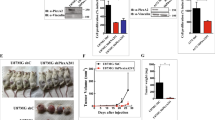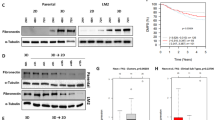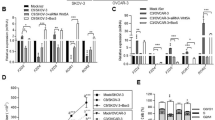Abstract
Cytokines can influence the interactions between members of the integrin cell adhesion receptor family and the extracellular matrix thereby potentially affecting cell function and promoting cell adhesion, growth and migration of malignant astrocytoma tumor cells. As malignant astrocytoma cells synthesize TGF-β1 in vivo, we analysed the effects of TGF-β1 on signaling events associated with integrin receptor ligation, focusing on the effects on paxillin, a phosphorylated adaptor protein, that acts as a scaffold for signaling molecules recruited to focal adhesions. TGF-β1-stimulation of primary astrocytes and serum-starved U-251MG malignant astrocytoma cells attached to fibronectin induced a substantial increase in the levels of paxillin protein (fivefold increase at 2.0 ng/ml) in a dose- and time-dependent manner compared to the levels observed on plating onto fibronectin in the absence of stimulation. In the astrocytoma cells, this resulted in an increase in the pool of tyrosine-phosphorylated paxillin, although it did not appear to alter the extent of phosphorylation of the paxillin molecules. In contrast, in primary astrocytes the protein levels were upregulated in the absence of a parallel increase in phosphorylation. The TGF-β1-stimulated increase in paxillin levels required ligation of the fibronectin receptor, as it was not induced when the cells were plated onto vitronectin, collagen or laminin. The increase in the pool of paxillin on TGF-β1 stimulation of the fibronectin-plated astrocytoma cells was associated with an increase in translation, but was not associated with an increase in the steady-state levels of paxillin mRNA. Stimulation with TGF-β1 on a fibronectin substrate increased subsequent attachment and spreading of U-251MG cells onto fibronectin and, to a lesser extent, vitronectin, but not collagen. Our results indicate that physiologic levels of TGF-β1 stimulate the expression of paxillin protein at the level of translation through a process that requires engagement of the fibronectin receptor, and promotes attachment and spreading of malignant astrocytoma cells on fibronectin.
This is a preview of subscription content, access via your institution
Access options
Subscribe to this journal
Receive 50 print issues and online access
$259.00 per year
only $5.18 per issue
Buy this article
- Purchase on Springer Link
- Instant access to full article PDF
Prices may be subject to local taxes which are calculated during checkout






Similar content being viewed by others
Abbreviations
- TGF-β1:
-
Transforming growth factor-β1
- TCA:
-
Trichloroacetic acid
References
Benveniste EN, Vidovic M, Panek RB, Norris JG, Reddy AT, Benos DJ . 1991 J. Biol. Chem. 266: 18119–18125
Fujita H, Kamiguchi K, Cho D, Shimanuma M, Morimoto C, Tachibana K . 1998 J. Biol. Chem. 273: 26516–26521
Giancotti FG, Ruoslahti E . 1999 Science 285: 1028–1032
Gladson CL . 1999 J. Neuropathol. Exp. Neurol. 58: 1029–1040
Gladson CL, Wilcox JN, Sanders L, Gillespie GY, Cheresh DA . 1995 J. Cell Sci. 108: 947–956
Hall A . 1994 Ann. Rev. Cell Biol. 10: 31–54
Kiyokawa E, Hashimoto Y, Kobayashi S, Sugimara H, Kurata T, Matsuda M . 1998a Genes Dev. 12: 3331–3336
Kiyokawa E, Hashimoto Y, Kurata T, Sugimura H, Matsuda M . 1998b J. Biol. Chem. 273: 24479–24484
Kjellman C, Olofsson SP, Hansson O, Von Schantz T, Lindvall M, Nilsson I, Salford LG, Sjögren H-O, Widegren B . 2000 Int. J. Cancer (Pred. Oncol.) 89: 251–258
Norman JC, Jones D, Barry ST, Holt MR, Cockcrofts S, Critchley DR . 1998 J. Cell Biol. 143: 1981–1995
Pijuan-Thompson V, Gladson CL . 1997 J. Biol. Chem. 272: 2736–2743
Pijuan-Thompson V, Grammar R, Stewart J, Tuszynski G, Silverstein RL, Pierce SF, Murphy-Ullrich J, Gladson CL . 1999 Exp. Cell Res. 249: 86–101
Riedy MC, Brown MC, Molloy CJ, Turner CE . 1999 Exp. Cell. Res. 251: 194–202
Sastry SK, Lakonishok M, Wu S, Truong TQ, Huttenlocker A, Turner CE, Horwitz AF . 1999 J. Cell Biol. 144: 1295–1309
Shibanuma M, Mashimo JI, Kuroki T, Nose K . 1994 J. Biol. Chem. 269: 26767–26774
Turner CE . 1998 Int. J. Biochem. Cell Biol. 30: 955–959
Turner CE, Brown MC, Perrotta JA, Riedy MC, Nikolopoulos SN, McDonald AR, Bagrodia S, Thomas S, Leventhal PS . 1999 J. Cell Biol. 145: 851–863
Wang D, Grammer JR, Cobbs CS, Stewart Jr JE, Liu Z, Rhoden R, Hecker T, Ding Q, Gladson CL . 2000 J. Cell Sci. 113: 4221–4230
Wang H, Chakrabarty S . 2001 J. Cell. Physiol. 187: 188–195
Zimmerman CM, Padgett RW . 2000 Gene 249: 17–30
Acknowledgements
This work was supported by grants #CA75682 and CA59958 from the National Institutes of Health, National Cancer Institute to CL Gladson and #NS34856, Project #2, from the National Institutes of Health, National Institutes for Neurologic Diseases and Stroke to EN Benveniste and CL Gladson.
Author information
Authors and Affiliations
Corresponding author
Rights and permissions
About this article
Cite this article
Han, X., Stewart Jr, J., Bellis, S. et al. TGF-β1 up-regulates paxillin protein expression in malignant astrocytoma cells: requirement for a fibronectin substrate. Oncogene 20, 7976–7986 (2001). https://doi.org/10.1038/sj.onc.1204996
Received:
Revised:
Accepted:
Published:
Issue Date:
DOI: https://doi.org/10.1038/sj.onc.1204996
Keywords
This article is cited by
-
Amniotic membrane promotes focal adhesion remodeling to stimulate cell migration
Scientific Reports (2017)
-
S100A4 promotes pancreatic cancer progression through a dual signaling pathway mediated by Src and focal adhesion kinase
Scientific Reports (2015)
-
Expression of PRMT5 correlates with malignant grade in gliomas and plays a pivotal role in tumor growth in vitro
Journal of Neuro-Oncology (2014)
-
Calumenin-15 facilitates filopodia formation by promoting TGF-β superfamily cytokine GDF-15 transcription
Cell Death & Disease (2013)
-
Scram1 is a modifier of spinal cord resistance for astrocytoma on mouse Chr 5
Mammalian Genome (2012)



